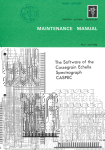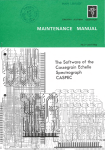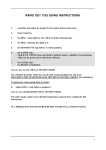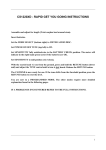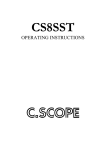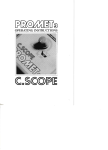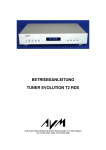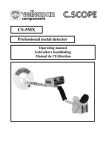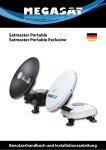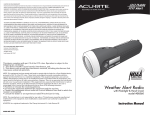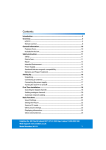Download C-SCOPE CS9000 MK2 Operating instructions
Transcript
CS9000 MK2 OPERATING INSTRUCTIONS CS9000 MK2 - RAPID GET YOU GOING INSTRUCTIONS Searching for a Metal Object 1. Turn MODE switch to BATT. CHK and check condition of the battery on meter. 2. Set THRESHOLD to the centre of the normal band. 3. Set SIGNAL BALANCE to the centre of the normal band. 4. Set GROUND BALANCE to the centre of the normal band. 5 Set AUTOMATIC THRESHOLD to No Auto. 6 Turn MODE switch to METAL 7. Hold detector with arm extended and raise and lower 6 inches. If the sound level does not change leave the GROUND BALANCE in NORMAL range. If the sound changes excessively then adjust as described in the section GROUND BALANCE PROCEDURE. 8. Switch AUTOMATIC THRESHOLD function on and begin search. Cave or Void Search 1. Set THRESHOLD to the centre of the normal band. 2. Set SIGNAL BALANCE to the centre of the normal band. 3. Set GROUND BALANCE to the centre of the normal band. 4. Set AUTOMATIC THRESHOLD to on. 5. Turn MODE switch to BATT. CHK and check condition of battery on meter. 6. Turn MODE switch to CAVE. Hold the detector with your arm extended and begin to search, taking care to keep the detector as level as possible and at a constant distance from the ground. IF A PROBLEM IS ENCOUNTERED REFER TO THE FULL INSTRUCTIONS. 1 User notes 2 CONTENTS PAGE INTRODUCTION ASSEMBLY INSTRUCTIONS BATTERIES CONTROLS 5 5 5 7 Mode Switch Threshold Signal Balance Ground balance Automatic Threshold Headphone Jack Socket Thumb Set 7 8 8 9 9 9 10 FEATURES 10 Automatic Threshold Ground balance 10 10 CS9000 MK2 OPERATION 10 Ground balancing Metal Mode Pinpointing Locating Caves & Other Voids ACCESSORIES (OPTIONAL) Headphones THE IMPORTANCE OF THE RIGHT APPROACH METAL DETECTING AND THE ENGLISH LAW CODE OF CONDUCT FOR METAL DETECTOR USERS CARE OF YOUR DETECTOR Storage Maintenance DETECTOR NOT OPERATING? Oscillating Signal Accompanied By Slight Meter Fluctuation Intermittent Sound From Speaker The Detector Drifts Out Of Tune Further Information SPECIFICATION 10 11 12 12 12 13 14 15 16 16 16 16 16 16 17 17 17 3 Controls 4 C-Scope CS9000 MK2 INTRODUCTION To protect your investment complete both sections of the enclosed guarantee card and return the reply paid portion to C-Scope. This is particularly important in order to obtain the free parts guarantee. (UK and Eire Only) Please retain the original packing box. In the event that your detector should ever require to be serviced, this package will be most suitable for postal protection. C-Scope detectors are recognised as the finest detectors available. They are designed with lasting quality, high technology, and above all, value for money. The only way to realise this value is to carefully study and understand this instruction manual. You will then be able to obtain all the advantages designed into your detector. It is also strongly recommended that you experiment with the detector's operation in air using various test samples, in order to learn to identify and understand the detector's capabilities and responses. Always remember that becoming a good metal detectorist is like becoming a good photographer or fisherman, that is, although it is an advantage to buy the best equipment, having bought it, patience and hours of practice are needed to become proficient. ASSEMBLY INSTRUCTIONS After all the parts have been removed from the shipping carton, assemble as shown on page 4. Be sure to keep all packing materials for future storage or shipping. BATTERIES The standard battery holder supplied with the detector holds four “C” size batteries. Alkaline types are recommended as they can supply consisitent power for longer time periods. Battery Holder 1. Remove the battery holder lid by applying gentle pressure down on the two locking tab openings on one side (just enough so that they unlock), flip the pack over and apply gentle pressure on the other two locking tab openings. The lid will then slip off 5 2. Insert the small foam squares inside the two springs on the lid, and also the two springs in the holder, this will prevent the loss of spring tension. 6 CONTROLS Mode Switch PWR OFF The first position on the MODE switch is the Power Off setting. Be sure the switch is returned to this position after using the detector. Failure to do so will result in the batteries being discharged. METAL In this mode the ground balance is in operation and all metal objects such as gold, silver, coin caches, iron chests, or even a septic tank lid can be detected. The metal mode will allow the greatest ground penetration and is the first choice for maximum capability. CAVE In this mode the ground balance is non-functional, and the CS9000 MK2 responds to all ground mineralisation changes. Because voids such as holes or caves have a distinct absence of mineralisation, the CS9000 MK2 responds by an increase in the sound. Usually ground density changes are detected as very broad response indications, and will change according to the operator’s position relative to the ground density changes. If the sound decreases of course this would indicate an increase in mineralisation. This mode will allow the detection of caves and other voids where treasure might be hidden. The use of this mode requires a very carefully planned search pattern, paying particular attention to broad changes in the sound. Marking the sites of each occurrence in a controlled search pattern will help in the location of these anomalies. BATT. CHK This position is used to determine the condition of the batteries which can be read on the meter. 7 Threshold This control adjusts the audio tone volume of the background noise, commonly called ‘threshold’. To adjust this to optimum, the sound should be barely audible. When using headphones, the control will be set lower than when using the speaker. It may be necessary when using the speaker where the environment is noisy to use a higher setting. Generally, the lower the setting, the deeper the detection. Signal Balance This control adjusts the Signal Balance or detection depth of the detector. The best position is in the NORMAL range of the control for most searching conditions. This will provide more than adequate depth with the most stability. If ground or interfering radio/electrical signals cause erratic behaviour (extreme fluctuations of the threshold tone) the SIGNAL BALANCE control should be set towards the MIN setting. If greater depths are required, the SIGNAL BALANCE control may be advanced further clockwise. Caution should be exercised when increasing beyond the NORMAL range. If the detector operates erratically because of higher setting, the response of deeper targets may be missed. The NORMAL range offers the optimum setting which will give smooth operation allowing deep targets to be heard clearly. 8 Ground balance This control is only effective when the METAL mode is selected. It is adjusted to cancel out the mineralisation in the ground and allow for maximum penetration. For higher mineralisation the control is rotated towards the (+) sign and subsequently towards the (-) sign for reduced mineralisation. The method to use for adjusting this control is covered under the section on OPERATION. Again, this control is only effective in the METAL mode. When using the CS9000 MK2 to hunt in the METAL mode, the Ground balance should be set in the NORMAL range. Finally, be sure that the AUTOMATIC THRESHOLD control is set to NO AUTO when adjusting the GROUND BALANCE control. Automatic Threshold When the Automatic Threshold is activated it enables the CS9000 MK2 to operate very smoothly over small changes in ground mineralisation that result in the threshold increasing or decreasing in intensity. It is necessary to keep the detector in motion while the Automatic Threshold is in operation. Standing still over a target will result in the signal slowly fading away. With the switch set to NO AUTO, The automatic threshold ceases functioning. The Ground balance is the only control that now compensates for the ground mineralisation. If the ground mineralisation does not change too rapidly this node can be used without the need to maintain motion of the detector. You may stand over the target without the signal gradually diminishing. It will be necessary (when not over a target) to periodically press the THUMB SET control to the momentary position in order to return the sound to its original threshold setting. Headphone Jack Socket The speaker is automatically disconnected as soon as the headphones are plugged in. Use of a headphone will produce maximum detection depth and longest battery life. Headphones with a 1 /4” plug and a stereo-mono switch are recommended. 9 Thumb Set The THUMB SET control is located at the tip of the handle. When using the CS9000 MK2 without the AUTO feature, the control may be pressed to the momentary position quickly with the loop over a target reducing the intensity of the signal making it easier to pinpoint. Further discussion of the use of the THUMB SET control is found in the OPERATION section. FEATURES Automatic Threshold The Automatic Threshold feature is a ‘self-adjusting threshold’, this is often referred to as “motion” mode, this feature maintains a smooth operating threshold, or background ‘hum’ while the detector is operated. This hum may drift up or down because of ground mineralisation changes that are present from one place to another during searching. Even though large changes in ground mineralisation will still require adjustment of the Ground Balance control, the smaller variations can be overcome with the Automatic Threshold feature. If the sound is permitted to drift too far from the proper setting, the depth performance of the instrument will decrease somewhat leaving some targets undetected. To activate the Automatic Threshold feature, simply move the switch to the AUTO. Ground balance A unique feature of the CS9000 MK2 is its’ ability to cancel the effects of ground mineralisation. This allows the detection of objects that would otherwise not be able to be detected because of the presence of mineral in the soil. While not all sites are affected by this phenomena, many will find this a very useful feature because of its’ increased depth of detection in very difficult soil. CS9000 MK2 OPERATION Ground balancing Metal Mode 1. Set the THRESHOLD, SIGNAL BALANCE, and GROUND BALANCE control knobs to the centre of the NORMAL range. Set the AUTOMATIC THRESHOLD control to AUTO. 2. Turn the MODE control to the BATT. CHK position and check the meter to determine the condition of the battery paCHK Then turn the MODE switch to the METAL position. The CS9000 MK2 will operate with these settings in the NORMAL range in most locations. However, if further adjustment is needed for ground mineralisation proceed as follows: - Ground balance Procedure i. 10 Set the AUTOMATIC THRESHOLD switch to the OFF. Make sure that the detector is well away from all large metal objects such as cars, pipes, rebar, etc. ii. Remove all metal objects from your person such as belt buckles, car keys, watches, knives, etc. iii. Hold the detector at arms length by your side in a comfortable carrying position, resulting in a distance of approximately 18 inches from the ground. Keeping the instrument level, press the THUMB SET control in the handle to the MOMENTARY position and release. The threshold tone is heard and the meter will indicate approximately ‘20’. Slowly raise the instrument approximately 6 inches. If the tone changes little or none, the setting is adequate for searching that area. Activate the AUTOMATIC THRESHOLD function and begin searching. However, if the tone does change significantly, leave the AUTOMATIC THRESHOLD off, and proceed in the following manner: iv. If the tone and meter reading went down when the instrument was raised, the GROUND BALANCE control needs to be moved slightly in the counterclockwise (-) direction. Lower the detector back to arm’s length, press the THUMB SET control to the MOMENTARY position to re-tune, release and again slowly raise the detector by 6 inches. If the tone continues to go down, repeat the procedure until the tone and the meter reading remain more or less the same in both positions. If the tone and meter reading go up when the CS9000 MK2 is raised, the GROUND BALANCE is too far toward the (-) and must be turned clockwise toward (+). The same procedure of raising and lowering is done looking for the same result of minimal change between raised or lowered position. The Ground balance procedure becomes more critical as the Signal Balance is increased. The SIGNAL BALANCE control does not need to be advanced past the NORMAL range for most applications. If the GROUND BALANCE procedure cannot be accomplished as outlined above, try moving to a different site as you may be over a buried metal object. Locating Buried Metal Objects The most efficient way to search an area is to use a grid-like pattern over the area selected. To minimise the chance of missing objects the maximum distance between grid lines should be no more than 6 feet. Making several passes in one direction, then turning 90 degrees, search the same area to assure that a buried object is not missed. It is normal for a fluctuating background noise to be heard with the signal from a target coming through much more loudly. Sometimes deeper targets will appear toward the rear of the CS9000 MK2. However the difference will usually be no more than 3 or 4 inches from the front loop, even for the deepest target. The volume of the tone will increase and the meter will read higher as the instrument is passed over a buried metal object. If the target is close to the surface, the meter may reach the maximum on the scale and the tone will no longer increase in volume. Remember to keep the detector in motion when using the AUTOMATIC THRESHOLD position when trying to locate the centre of a target. If the detector is held motionless over the target, the sound will fade. A system of crisscrossing at 90 degrees will aid in pinpointing the centre of the target. 11 Pinpointing In the AUTOMATIC THRESHOLD OFF position, a surface target can appear to be very large, which is normal. Now the target must be ‘narrowed down’ to determine its’ location more accurately. Start to pass over the target from one direction, when the meter goes ‘off scale’ press the THUMB SET control to its’ MOMENTARY position briefly to bring the meter back on scale. Continue to cross the target in the same direction and repeat the pressing of the switch. There will be a point where the meter reading and speaker tone will ‘peak out’ and start to drop back down. It is at this peak that the front loop is over the buried metal object. Pressing and releasing the MOMENTARY position of the switch will cause the target to appear to shrink making pinpointing easier. The AUTOMATIC THRESHOLD allows the pinpointing to take place automatically. Locating Caves & Other Voids 1. Set the MODE switch to the CAVE position. Set the THRESHOLD, SIGNAL BALANCE and the GROUND BALANCE controls to the NORMAL range. The TONE and SIGNAL BALANCE control may be readjusted to optimise for the location you are hunting in just as was done for the GROUND BALANCE METAL MODE. 2. The AUTOMATIC THRESHOLD or the non-motion position may be used. Use the one that gives you the smoothest performance and is the most comfortable. If there are rapid ground changes and there is difficulty maintaining a threshold the best choice is AUTOMATIC THRESHOLD. If you are an experienced user you may wish to leave AUTOMATIC THRESHOLD off. A constant position with no changes in elevation with respect to the ground is necessary to avoid false indications. It is not recommended that you search in this mode unless you are looking for changes in ground density. Again, make sure that the CS9000 MK2 is maintained in as constant a position above the ground as possible. Operation in the CAVE mode will produce a positive sound for all non-ferrous metals such as gold or silver, and will produce the same response from voids, such as a cave. When a ferrous target, such as iron, is encountered, the sound will respond by going quiet. The same is true if there is heavy iron mineralisation. Since the ground balance is not affected in the CAVE mode, leave the GROUND BALANCE control at the NORMAL range. Because the ground mineralisation is not cancelled, the CAVE mode does not achieve the depth that can be expected in the METAL mode. ACCESSORIES (OPTIONAL) Headphones Headphones not only extend battery life but improve Signal Balance by cutting extraneous noise. The headphones should be fitted with a standard stereo 1/4 inch (6.35mm) jack plug. 12 THE IMPORTANCE OF THE RIGHT APPROACH Treasure hunting can be a profitable and rewarding hobby, if approached in a patient and diligent manner. Time spent researching to locate a worthwhile site for a search can be time wasted if your search is hasty and erratic. To achieve maximum results it is important then, to decide on your approach to any particular site in advance of the actual search. Tactics will be decided by the type of site - it is more profitable to scan a small area thoroughly than to conduct a haphazard search of the total site. However, when the site is too far away for you to make several return visits, a plan should be adopted which gives maximum coverage, at the same time as indicating the most likely area for detailed search. Your detector alone is not a guarantee of successful treasure hunting. Any detector needs an operator and for the best results the operator needs the right approach, attitude and technique. Too many beginners neglect the importance of pre-planning and research before using their detector in the field, and patience and technique during the actual search. A successful search should begin with research some time before the day of the actual search. The extent and thoroughness of your research will be one of the major factors in the success of your detecting. You should aim to get as complete an understanding as possible of the local history and geography. The key to the choice of site is to think of people, where they congregated over the past few hundred years. What were their customs and pursuits? Where did they spend money? Where did they carry money? The answers are not Roman sites, nor are they associated with mystic treasure stories of crocks of gold. Rather, they are unassuming, undramatic places, like public footpaths and ancient rights of way, old houses and so on. When you have chosen your site, allocate a whole day from early morning to early evening for the search. Make sure you have all the equipment you are likely to need. Your detector should be checked before starting out, and you should always carry a spare set of batteries. You will also need a strong, sharp trowel. It is also a good idea to have a set of lines and pins so that you can lay out your search area scientifically. Most beginners make the mistake of rushing about hoping to chance upon a rare find. If for example there happened to be a valuable ring that was buried 4" deep on the site you were searching, if you rushed about haphazardly and quickly on the site, the odds would be very much against you finding it. On the other hand, if you pegged out the area scientifically and searched slowly and thoroughly, the odds of finding the ring would be very much more in your favour. Remember, BE PATIENT and WORK SLOWLY. Do not try to cover too large an area, restrict yourself to a small area and work through it thoroughly. Make a note of the position and the extent of the area, and then when you return you can start again further on without missing any ground or covering the same area twice. It is also important to keep the detector head as close to the ground as possible. Ideally, you should 'iron' the ground with the search head of the detector, so that you do not lose any detection 13 range. Similarly, if you work slowly and carefully you should be able to distinguish the faint signals as well as the clear-cut signals and further increase your finds. The technique of getting the best out of your detector is not learnt overnight. You need to get as much experience as possible so that you can recognise every kind of signal. Indeed, a good detector operator can often tell you what is being detected before it is unearthed. METAL DETECTING AND THE ENGLISH LAW The rights of the finder fall into two distinct classes. The first relates to objects that have been recently lost, and the second to items of gold or silver which are subject, or might be subject, to the laws of the Treasure Trove. In the first place, where the object has been recently lost and found and is valuable, it should be handed to the Police as soon after it has been found as possible. The Police will then attempt to locate the owner. If they succeed in locating the owner, he has the legal right to the object and is not legally bound to reward the finder. That is a matter for the owner's conscience. In the event of the Police failing to locate the owner they will probably return the object to the finder. If, however, the owner makes a claim for the object at a later date, the finder must return the item to the owner. If the owner is not located the finder has the best rights to ownership, provided that the object was not found on private property, in which case the owner of the land has a better right than the finder. The solution here, of course, is to obtain permission beforehand and to come to some agreement with the landowner with regards to the division of any finds. If on the other hand, the find of gold or silver can be proved to have been deliberately concealed, with a view to recovery at a later date, the find comes under the law of the Treasure Trove. If the objects cannot be proved to have been deliberately concealed, the find cannot be declared Treasure Trove. Usually this point centres around the quantity of coins in a hoard, or whether the find is in a container. Obviously, if there are a hundred coins in a pot, they were almost certainly deliberately concealed. If, however, there are only one or two coins, it is more likely that they were lost accidentally. If the objects are declared Treasure Trove, the finder has no need to worry, for he is usually rewarded with a cash settlement to the full market value of the find. When the objects are not declared Treasure Trove, the owner of the land on which the find was made usually has a better claim to ownership than the finder. In Scotland all newly discovered ancient objects of all metals, whether deliberately concealed or not are subject to the same procedure as Treasure Trove finds in England. 14 CODE OF CONDUCT FOR METAL DETECTOR USERS 1. Do not trespass. Ask permission before venturing on to any private land. 2. Respect the Country Code. Do not leave gates open when crossing fields, and do not damage crops or frighten animals. 3. Do not leave a mess. Use a sharpened trowel or knife to cut a neat circle or triangle (do not remove the plug of earth entirely from the ground); extract the object; replace the soil and grass carefully and even you will have difficulty in finding the spot again. 4. Help to keep Britain tidy - and help yourself. Bottle tops, silver paper and tin cans are the last thing you should throw away. You could well be digging them up again next year. Do yourself and the community a favour by taking the rusty iron and junk you find to the nearest litter bin. 5. If you discover any live ammunition or any lethal objects such as an unexploded bomb or mine, do not touch it. Mark the site carefully and report the find to the local police. 6. Report all unusual historical finds to the landowner. 7. Familiarise yourself with the law relating to archaeological sites. Remember it is illegal for anyone to use a metal detector on a scheduled ancient monument unless permission has been obtained from the Historic Buildings and Ancient Monument Commission for England or the Secretary of State for the Environment in Scotland and Wales. 8. Remember that when you are out with your metal detector, you are an ambassador for our hobby. Do nothing that may give it a bad name. 15 CARE OF YOUR DETECTOR Storage When not in use your detector should be stored in a dry warm environment. If it is not to be used for a certain length of time it is advisable to remove the batteries to avoid leakage which could cause serious damage. The working life of your detector will be shortened by careless use or neglect of the unit. Think of your detector as a scientific instrument. Your detector is designed to withstand rugged handling on any terrain, but misuse or lack of due attention will tell in the end. Maintenance Make sure that the antenna fits on the shaft stub in a snug manner. If they are loose they may be tightened by prying out the ‘slots’, that are located on each of the main shaft stubs, with a knife or screwdriver. DETECTOR NOT OPERATING? (a) (b) (c) Check the condition of batteries under load using the meter. (See Battery Check Procedure). Check that the antennea is properly attached to the control box. Interchange batteries and ensure connections are correct and secure. Battery life can vary tremendously between makes, therefore your 'new' batteries may already be insufficiently powerful to run the detector. Oscillating Signal Accompanied By Slight Meter Fluctuation (a) (b) (c) This could be due to poor battery connections. Ensure that they are tight and the batteries are securely clipped into place. Loose antenna connection. Interference from a vehicle using a radio transmitter or possibly a stationary source of electromagnetic radiation - if this occurs then reduce the Signal Balance. If the problem persists then the best remedy is to wait until the transmission stops. Intermittent Sound From Speaker (a) 16 This could be due to poor battery connections. Ensure that they are tight and the batteries are securely clipped into place. (b) Loose antenna connection. (c) Radio interference (see above). The Detector Drifts Out Of Tune (a) (b) Temperature drift caused by change in air temperature when a machine is moved from a house or car into the open. The greater the change in temperature the more the drift, and in severe conditions up to 30 minutes may be needed for the electronic circuitry to acclimatise itself. Sometimes battery drain can cause drift of signal. Replace batteries and this should help to maintain a stable signal. Further Information If you experience any difficulty in operating your CS9000 MK2, or have any questions on the information in your CS9000 MK2 Operating Instructions Manual, please do not hesitate to contact our Customer Service Department on +44 (0) 1233 629181. Before returning a detector for repair to C-Scope ensure you have done the following:(a) (b) (c) Read the instructions thoroughly. Tried new batteries and checked procedure outlined above. Return your detector with a letter giving full details of fault. SPECIFICATION 1. Operating frequency: 12.5 KHZ (nominal) 2. Operating temperature: -5oC to +55oC 3. Battery type and life: 4 x C size 1.5 volt cells, approx. 20 hours use. C-Scope International Ltd reserves the right to modify, improve, or otherwise change the design capabilities or specifications of its’ detectors without further notice. This equipment conforms to the EMC Directive 89/336/EEC. However, system performance may be impaired by unusually strong electromagnetic fields. 17 Kingsnorth Technology Park, Wotton Road, Ashford, Kent TN23 6LN Telephone: +44 (0) 1233 629181 Fax: + 44 (0) 1233 645897 www.cscope.co.uk email [email protected] Issue 1 (7/01) B1062



















